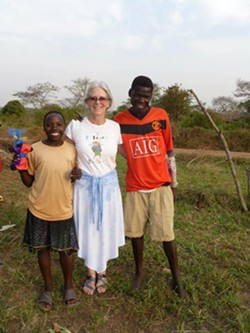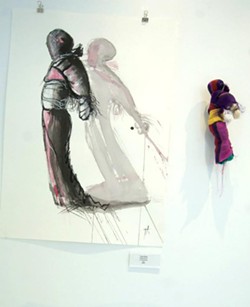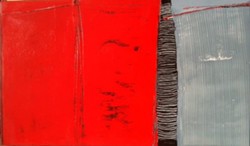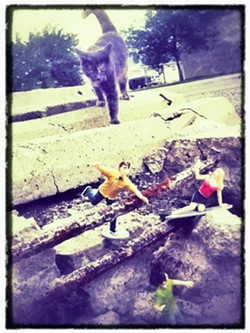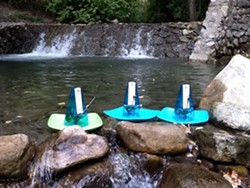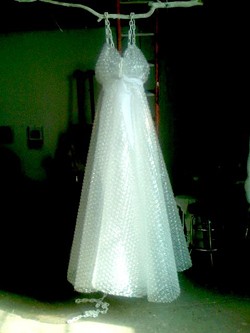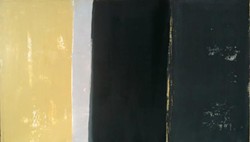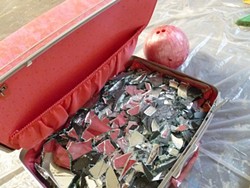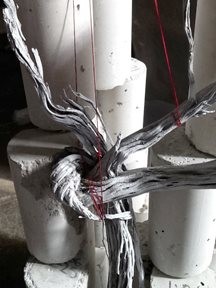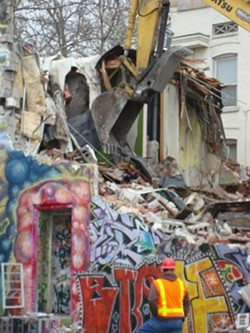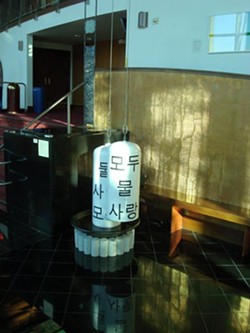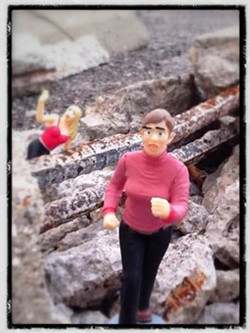Wednesday, January 4, 2012
Trent Alvey
Posted By Gavin Sheehan on January 4, 2012, 11:00 AM
Trent Alvey has been a driving force in Utah arts for over two decades, creating experimental and unique mixed-media pieces that have left audiences intrigued and giving aspiring locals the inspiration to push forward with their artistic careers. --- Alvey has served as a mentor, received awards and recognition and has a permanent piece at the UMFA, but still continues to create work from her space at Captain Captain Studios.
Alvey continues to inspire those coming up, sharing her space with artists who are looking to perfect their craft, while expanding her own body of work in private exhibitions and occasional open houses that look to inspire more artists for years to come. Today, we chat with Alvey about her career and works she's created, along with her thoughts on current local art.
Trent Alvey
Gavin: Hey, Trent. First thing, tell us a little bit about yourself.
Trent: I’m an amalgamation of twists and turns, years upon years, slipping glimpses, lateral perceiving and lasting impressions, all of which eventually comes out in my art. I’m a full-time artist in SLC. I use art to make sense of the world. I am able to travel a great deal. I traveled to Uganda a year ago and did a project with the Acholi children ravaged by war. My husband and I travel a lot, too. He directs a conservation/educational organization, Round River Conservation, based in SLC. We have projects in Namibia, Botswana, Chile, Canada and the Colorado Plateau. Travel helps me to realize the similarities and differences in cultures, landscapes, political and historical scenes. We are immersed in these local communities and I get a chance to internalize the often-complex situations. But, then I begin to realize the archetypal patterns that emerge around wildlife, large wild landscapes and indigenous people. In a nutshell: Emergent patterns interest me a great deal -- really the geometry (sacred geometry, if you will), the universality of how people construct their lives using the resources they have at hand.
Gavin: What first got you interested in art and what were some early influences on you?
Trent: Two junior high school teachers. An art teacher, David Chaplin and a creative writing teacher, Claudia Sizemore, introduced me to the world of self-expression. It seemed to me that I’d found my best friends in art and writing. Since then, I’ve always worked out everything in creative expression. On my recent trip to Uganda, my belief [solidified] that creativity is so much more than an indulgence in making pretty art for someone’s home; it is an essential tool of survival. And sometimes it’s not pretty. Please Google and YouTube: Uganda, Trent Alvey.
Gavin: You earned your BFA at Westminster College in 1986. What made you choose Westminster and what was its program like for you?
Trent: Nurturing, in a word. I lived across the street from Westminster and I started working as the graphic designer for the college. I met so many incredible people there, dedicated and willing.
Gavin: What was it like for you studying under Don Doxey and what lessons did you learn from him that you still apply today?
Trent: Working and going to school at Westminster allowed me to attend Don’s figure-drawing class four days a week for the five years that I worked there. It was a superb way to gain drawing skills. Don also instructed me in painting. He was the master of painting surfaces: metal, wood, fur, and cloth or water. He showed me a lot of techniques that I still call upon.
Gavin: What made you decide to be more of a mixed-media artist rather than pick a specific genre and master it?
Trent: I have a couple of themes that I’m always trying to communicate or work out in my own mind. Through my art, I’m working on a question, either personal or archetypal, which I’ve finally figured out are the same thing; at least they are fractal: One is a smaller enigma that fits inside the larger, and larger, and larger question. They are self-similar like Mandelbrot’s fractals. Non-linear things or systems, which seem to be random like water, fire or clouds can be measured by what is now called the geometry of chaos. I’ve found a few doorways or tools into quantifying certain concepts using mediums; the concept is quite often the same. For example: dichotomies and how opposites harmonize, sometimes by slamming them together; repetition/pattern and its deeper spiritual workings; making frequency visible (the study of Cymatics); and in general the language and concepts of physics which help us to understand that the physics of consciousness really does create our tangible personal world.
Trent: I did a Cymatics installation project where sound vibration visibly travels through water. It was installed at Rose Wagner Performing Arts Center last May for Water Week. I called it Water Music. I invited Gentry Densley to help me create the sound cycle, creating a pattern of reverberation. (YouTube Video - Trent Alvey, Water Music.). The 2-D work, the painting, which I think embodies this concept, is The Great Perfection (84” x72”). Sometimes I take a break and just have fun playing with scale, as in the Partner’s exhibit last summer at Art Access. My installation incorporated some broken-up concrete parking barricades and some tiny Horrified B-Movie Victims. I moved the concrete into the gallery with the help of some temp workers. They were quite entertained by the whole thing, which was a good indicator to me that the work was working as I had intended.
Gavin: Was it difficult for you to apply so many different techniques to your work early on, or was it simply a matter of learning it as you go?
Trent: I had a graphic-design business for 20 years and I learned to be very resourceful with techniques and ideas. If I needed a certain style or illustration, I just created it. That was possible because of graphic-arts training I received at Salt Lake Community School and Westminster College. When I quit my graphics business, I was producing art fast and furious. I actually had to learn to slow down; otherwise, I’d have buried myself in work. Being a full-time artist allowed me time to just explore new techniques and allow the incremental progress to happen.
Gavin: Aside from fine art, you also studied communications and took up jobs at companies such as XMission. What made you choose that as another career, and how was it for you finding a balance between that and art?
Trent: Actually, I never worked at XMission. That is one of those Internet misinformation nuggets. Just worked as a graphic designer, started my own graphic-design business, cleverly called Trent Alvey Design. My focus was arts and environment. I worked for Sundance, the Cowboy Poetry Gathering, the Utah Arts Council, Utah Humanities, Salt Lake Community College, The Nature Conservancy, the Salt Lake City Arts Council and Westminster College. I was so fortunate to get to know many of the great, creative people and arts administrators in SLC.
Gavin: How was it for you breaking into the local art scene during this time and being regarded as an experimental artist among your peers?
Trent: I’d have to say, easy. The art community is so inviting and accepting. I think there is no other group of people so accepting. All you have to do is show that you are serious, not a hobby artist and you are in. I’m fortunate to be working everyday with some dedicated artists at Captain Captain Studios.
Gavin: What's the process for you when creating a new piece of art, from initial concept to final design and exhibition?
Trent: The process varies, but generally there are two ways. One is that I find an object that I think I can use, and try putting it with other objects that I have in my studio, until I hit a spark. When I get the combination right, it just snaps into existence. I like to say that I have everything in my studio or vicinity that I need to create the work. That comes from the Buddhist concept that everything you need to be happy is within you. (of course, this requires constantly replenishment). My classic example of this is my Nine Foot Tall Brides Dress. I had a giant roll of bubble wrap in my studio left over from my work Archetypal, in which a blue light shown through the pyramid-shaped bubble wrap, making it appear as little jewels. I just used the left over bubble wrap to create a nine-foot-tall wedding dress with enigmatic yellow chain trailing from under the dress. The second process is to begin with a theme, and looking specifically for objects that will evoke the concept you have in mind. I did that with Venus Deconstructed, finding all the materials I needed in my studio. I utilized about 50 concrete core samples that I’d dug out of a dumpster about five years ago. Also I found a small rusty pulley, an elegant piece of dried and whitewashed sagebrush and some red thread. I created a mechanized archetypal structure, which to me represented Venus Deconstructed. With painting, I usually get a slipping glimpse of something, some 2-D visual that looks like a painting already. Then, I try to get it painted before the muse leaves me. I find that my painting process is much more fleeting, unlike the object work. I find that if I don’t act on an idea image for painting in a timely way, it will leave.
Gavin: Considering how some of the works come together, do you tend to play around with how they look or function before they're finished, or do you try to stick to the initial idea?
Trent: I always play with objects or painting concepts before I have a full-blown idea. Usually it’s just that glimpse of some idea in its initial stage. I always deviate and allow the process to unfold intuitively – that is the creative art process. I do have some concept of what I’m trying to accomplish and I find that I stick to the original idea until I see a way to improve on it. One of the few pieces that I’ve actually stuck to the original idea was for a group exhibit, Year of the Rabbit curated by Ruth Lubbers at Art Access. Each artist was given a fortune on which to base their project; mine was A Broken Mirror Has Many Reflections. I decided to do an installation derivative of Robert Smithson’s Atlantis (1961), which is now permanently installed at the Dia Beacon. He had shaped broken glass into the imaginary configuration of the continent of Atlantis. My derivation was broken mirror glass in the shape of a rabbit. So I stuck very close to the concept, since the concept was the most important part of the work. But, then the fun began with a secondary process piece called Trish (Trent) Goes Bowling.
I got a few of the artists at Captain Captain to join me (Trent Call, Tessa Lindsay and Justin Carruth) and asked my friend and video artist Jan Andrews to video the process. (YouTube: Trent Goes Bowling). With a pink bowling ball engraved with “Trish” and a pink Samsonite suitcase from Deseret Industries, I set up rather large, donated pieces of glass in an empty studio. And we all went bowling. I gathered up the broken chards of glass and loaded them into the fleshy, pink-satin suitcase. The sight of it was so visceral and excruciatingly dichotomous, that I knew I’d created art. This happens to me a lot; my body instinctively knows the objects to pick up and put together. If I am open for anything, the alchemy happens effortlessly and without self-consciousness or predetermination.
Gavin: Being how you are experimental and like to work with mixed media, what kind of a challenge has it been for you personally to continue to be innovative and try new pieces out?
Trent: I don’t think of it as challenging as much as intriguing, captivating or necessary. Fun would also describe it. You know ... if you’re not having fun ... you know.
Gavin: You've also had a piece added to the U's Museum of Fine Art in its permanent collection.
Trent: Yes, that is Toaster Worship, it was acquired by the UMFA about six years ago. It is an honor to have my work in such a formidable collection. The piece is funny, but also reflects the dogma and stereotypes present in the culture, especially prominent when I was growing up. The work is heavily influenced by the domesticity of the 1950s, but showing a flair for reckless abandon. Come to think of it, that was one of my original 3-D works and it set the stage for many works to come: examination of opposites in all categories of life -- emotional, social, philosophical and archetypical.
Gavin: For your art space, what made you decide to move into Captain Captain Studios, and how has it been for you working in that environment with so many talented artists?
Trent: "Between herding cats and raccoon visits, accretions, diversity, personal agendas, ambition and the lack thereof, lies the group of artists at Captn’ Captn’." This is a quote that Tessa Lindsay, Chase Leslie and I wrote to introduce the last Captain Group show at Utah Arts Alliance. We tried to capture the looseness and tightness of the studio participants. We had, at the time, a raccoon that frequented the rafters at night and a few feral cats running about. About eight of us moved over here from the old Poor Yorick Studio, just a couple of blocks away. Skylar Nielsen had just purchased the building to be used as artist studios. Originally the artists, in addition to myself, were Tom Mulder (now deceased), Mandate Press, Sri Zeno Whipple, Steven Larsen, Trent Call, Tessa Lindsey, Chase Leslie and James Randall. I have a new studio mate now, Chris Rudert. He is very talented and says he’s going to start doing grown-up painting. I actually discourage that. The studio works out really well. I love being in the midst of bubbling talent, essential creativity and youthful exuberance.
Gavin: One of the more recent big group projects you were involved with was the 337 Project. How did you become involved with that, and what was it like for you being a part of that exhibition?
Trent: Trent Call asked me if I wanted to meet Adam Price and get involved. Adam was looking for 50 artists originally, and it turned into over 150 participating artists. In hindsight, the project has had a lasting presence that I didn’t think about at the time. It was a major collaborative effort and a meaningful exercise in group non-attachment; since the building was torn down afterwards, all artists were good with the temporal concept. Even though we did not work in a truly collective way, there was a great sense of being part of the whole. I worked in three areas of the building. One was the Frequency Generators hooked into the building intercom. Christian Ariel and Craig Cleveland helped me hook up my Cymatic sculptures. Another was the Jihadi Girl in the front stairwell, my first spray-paint work. And third was the Top Secret: Radiation Closet, exploring the open-air atomic testing in the '50s-'70s and the implications of radioactive iodine on the human thyroid. I think that Adam Price and the 337 Project did a lot to help the art community to evolve – to make it more confident.
Gavin: Most recently, you received the Mayor's Award at the Utah Arts Festival as part of your accolades. What did you think about the honor and what did that award mean to you?
Trent: This award was such a great honor for me and it was an acknowledgment of my persistence and talent. I shared the distinction with four other artists and arts administrators: Ruth Lubbers, Charles Lynn Frost, Carol Edison and The Book Arts Program.
Gavin: With all the work that you've done and achievements you've earned in your career so far, do you have any bigger goals that you're aiming for or works you'd like to create?
Trent: No. I think I’m all done. Of course, for one, I’d like to sell more art. Since my work is so variable, I think that buyers are a hesitant to jump into some of my assemblage and experiential work. “Experiential" is a new adjective I’m using for work that involves a project with some action, documentation in the form of drawings, video, sound recordings, GIS mapping, scientific contributions. One project that I have coming up next June is one of the “experiential works” entitled SYNCHRONICITY. I’d call this conceptual work. It tried out the verbs to describe my actions: demonstration, experimentation, but I think I like empirical learning by observation or experimentation using working hypotheses that are testable.
Gavin: Moving on to local art, what are your thoughts on our art scene, both good and bad? And is there anything you believe could be done to make things more prominent?
Trent: I think the art scene is on an upward trajectory. I think there is a lot of movement. I see more creative-discipline crossover with conceptual, performance, visual and sound and more collaboration; more artists breaking out of their confines and experimenting with new genres -- I know that’s what I’m doing even though I had very few confines to start with. I think that the bad part of the art scene is that most galleries are too conservative. Traditional galleries are sort of boring. An exception may be Nox Contemporary started by John Sproul and Central Utah Art Center in Ephraim, Utah. I really enjoyed visiting the Center for Land Use Interpretation Museum in the old Wendover Airfield in Wendover. In the interest of full disclosure, I am on the board of Utah Museum Of Contemporary Art -- formerly Salt Lake Art Center -- and I think that they are really on the path to becoming a world-class contemporary-art museum. I think that Utah is finally coming into its own in regard to contemporary art.
Gavin: Who are some local artists you believe people should be checking out these days?
Trent: The artists I find really exciting are Jenevieve Hubbard, Tessa Lindsey, Mike Barnard, Jared Clark, Jan Andrews -- film maker -- Gailon Justice, John Sproul and Emily Plewe. Of course, I have favorite artists that have been around a long time, but are under-appreciated like Gary Vlasic, Layne Meacham, Paul Barnhard and Daryl Erdman.
Gavin: What's your opinion on Gallery Stroll today and the work being displayed each month?
Trent: Gallery Stroll has to be revitalized. It is getting a little stale. UMOCA has introduced First Night First Friday of every month. It is intended to be a party around introducing a new exhibit. They have lots of great music, food and wine. There is an excitement surrounding it. It reminds me of First Night at the High Museum in Atlanta.
Gavin: Having been involved with the art scene as long as you have, how would you compare the scene today to when you first started, and what would you like to see change in today's movements?
Trent: I like to see change and progression whether or not I see it as better or worse. I think that with concept art the idea is more important than the work is interesting. I like to see how new or rediscovered concepts show up. They emerge as phenomenon. They rise up simultaneously in all parts of the country and internationally. All of a sudden artists are thinking of similar approaches to art. I think that the science of emergence is as interesting as the art. I like the idea that artists everywhere are combining art with concepts of social phenomenon, education, science, environmentalism, so on and so forth.
Gavin: What can we expect from you over the rest of this year?
Trent: SYNCHRONICITY. Speaking of the emergence of artistic movements, I’m stretching a little, too. I want to do a conceptual work around water systems. The larger concept will be to metaphorically synchronize a creek -- a water system is a nonlinear complex system -- specifically, creeks that feed our community. It will include GIS data and a physics demonstration of synchronicity.
Gavin: Is there anything you'd like to plug or promote?
Trent: Yes. Utah Museum of Contemporary Art and their amazing new programing, grants and collaborations: In the interest of full disclosure, I’m on the Board of UMOCA. I think that Adam Price, as the new director (two years in), is truly reinventing the former Salt Lake Arts Center. He is technically an outsider, no art degrees, only a genuine love of art and a formidable sense of organization. He has applied new creative energy that can only come from a diverse background. Sometimes “experts in a field” are too immersed in what can’t be accomplished, rather than what can be done. Adam and his staff are fabulous. In the past 12 months, the Art Center has exhibited work by leading national and international artists, including TED presenter Miwa Matreyek; MacArthur Genius Award recipient Bill T. Jones; Guggenheim Fellow Jennifer Nelson; Venice Biennale artist Daniela Comani; 2011 Rome Prize winner Mary Reid Kelly; recipient of the Leone d'Oro award for Lifetime Achievement, Barbara Kruger; and the inaugural recipient of the Catherine Doctorow Prize for Contemporary Painting, Kim Schoenstadt.
On Dec. 2, UMOCA opened a new exhibition by German artist and Fulbright scholar Mirko Martin, and in January, UMOCA will exhibit artists working at the cutting-edge of digital media as part of Sundance Film Festival's New Frontier. UMOCA’s first annual Catherine Doctorow Prize for Contemporary Painting ($15,000 prize and a solo exhibition) was awarded to Kim Schoenstadt. Jared Clark was the first artist to exhibit in the new Local’s Only Gallery.
| Follow Gavin's Underground: |
On Topic...
-
Film Reviews: New Releases for April 12
Civil War, Escape from Germany, Coup de Chance, Hundreds of Beavers, La Chimera, Sting
- Apr 11, 2024
-
Film Reviews: New Releases for April 5
Monkey Man, The First Omen, Wicked Little Letters, Girls State, Scoop, Exhuma
- Apr 4, 2024
-
Music Plus: March 29
Das Energi Festival headliners, Ogden Twilight lineup
- Mar 29, 2024
- More Gavin's Underground » More Culture »
More by Gavin Sheehan
-
Gavin's Underground: End Of An Era
Nine and a half years of local entertainment blogging comes to an end.
- May 26, 2017
-
Torris Fairley
A quick interview with the up-and-coming SLC-based comedian.
- May 25, 2017
-
Cirque Asylum
A look into the dance school teaching unique forms of aerial arts.
- May 24, 2017
- More »




